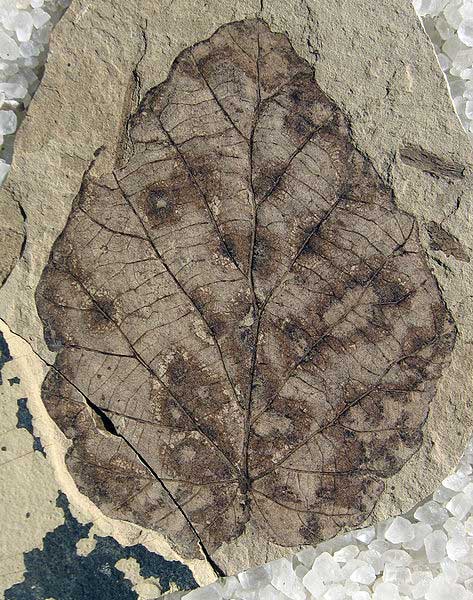
Fothergilla malloryi (*)
Classification System: APG IV
Superregnum: Eukaryota
Regnum: Plantae
Cladus: Angiosperms
Cladus: Eudicots
Cladus: Core eudicots
Ordo: Saxifragales
Familia: Hamamelidaceae
Subfamilia: Hamamelidoideae
Genus: Fothergilla
Species: †F. malloryi
Name
Fothergilla malloryi Radtke, Pigg, & Wehr 2005
Type locality
late Ypresian; "Boot Hill"(UWBM Location B4131), Tom Thumb Tuff Member, Klondike Mountain Formation, Republic, Washington, USA
Type material
Holotype: Burke Museum of Natural History and Culture, University of Washington, Seattle, Washington, USA UWBM56625
References
Radtke,Meghan G., Pigg, Kathleen B., & Wehr, Wesley C. (2005); "Fossil Corylopsis and Fothergilla leaves (Hamamelidaceae) from the Lower Eocene flora of Republic, Washington, U.S.A., and their evolutionary and biogeographic significance" International Journal of Plant Science 166(2):347–356
Fothergilla malloryi is an extinct species of flowering plant in the family Hamamelidaceae known from fossil leaves found in the early Eocene[1] Klondike Mountain Formation deposits of northern Washington state.[2] The F. malloryi leaves are the earliest appearance in the fossil record of a member of the witchalder genus Fothergilla, which includes the living species F. gardenii, and F. major, both of which are native to the southeastern United States.[2] The genus also includes three or four other fossil species with two Asian Miocene species, F. viburnifolia from China, F. ryozenensis from Japan along with one Miocene North American species, F. praeolata of Oregon. Fothergilla durhamensis described from Eocene sediments in King County, Washington is considered dubious in placement,[2] and it was transferred to the genus Platimeliphyllum by Huegele et al. (2021).[3]
History and classification
Fothergilla malloryi is represented by a single counterpart compression fossil specimen from the Ypresian[1] aged Klondike Mountain Formation which outcrops in Republic, Ferry County, Washington. The age of the formation is based on Argon–argon dating, which has returned a date of 49.4 ±0.5 million years old.[2] The fossil was recovered from "Boot Hill", University of Washington site UWBM B4131 located within the city limits of Republic.[4]
The holotype specimen for Fothergilla malloryi is numbered UWBM 56625 and currently preserved in the paleobotanical collections of University of Washington in Seattle, Washington.[2] The specimen was studied by paleobotanists Meghan G. Radtke and Kathleen B. Pigg of the School of Life Sciences, Arizona State University and Wesley C. Wehr of the Burke Museum of Natural History and Culture in Seattle. Radtke, Pigg and Wehr published their 2005 type description for F. malloryi in the International Journal of Plant Sciences. The etymology of the specific name malloryi was derived from V. Standish Mallory, University of Washington professor of geology and paleontology,[5] in honor of his contributions to the Tertiary paleontology of Washington State.[2]
Description
The specimen used for the description of F. malloryi is a simple, ovate leaf having a slightly asymmetric base. The overall length of the leaf is 4.4 centimetres (1.7 in) and is 3.5 centimetres (1.4 in) at the widest point near the base. The pinnate secondary veins diverge from the primary vein at an angle of 53° and form a craspedodromous patterning. The leaf margin has large rounded, possibly glandular teeth each with a single major vein. F. malloryi is similar in size range to the extant F gardenii and the Miocene F. viburnifolia, but differs in the structuring of the leaf base. F. malloryi is generally shorter and less elongated then the Miocene species F. ryozenensis while the Oregon species F. praeolata has a notably different overall shape and petiole structure.[2]
References
Manchester, S.; Pigg, K (2008). "The Eocene mystery flower of McAbee, British Columbia". Botany. 86 (9): 1034–1038. doi:10.1139/B08-044.
Radtke, M.G.; Pigg, K.B.; Wehr, W.C. (2005). "Fossil Corylopsis and Fothergilla Leaves (Hamamelidaceae) from the Lower Eocene Flora of Republic, Washington, U.S.A., and Their Evolutionary and Biogeographic Significance". International Journal of Plant Sciences. 166 (2): 347–356. doi:10.1086/427483. S2CID 20215269.
Huegele, I.B.; Zhu, H.; Zhao, B.; Wang, Y.-F.; Manchester, S. R. (2021). "Trans-Beringial Distribution of Platimeliphyllum (Platanaceae) in the Eocene of Eastern Asia and Western North America". International Journal of Plant Sciences. 183 (2): 139–153. doi:10.1086/717692. S2CID 239529168.
Pigg, K.B.; Manchester, SR; Wehr, WC (2003). "Corylus, Carpinus, and Palaeocarpinus (Betulaceae) from the Middle Eocene Klondike Mountain and Allenby Formations of Northwestern North America". International Journal of Plant Sciences. 164 (5): 807–822. doi:10.1086/376816. S2CID 19802370.
V.-Standish-Mallory Encyclopædia Britannica>
Retrieved from "http://en.wikipedia.org/"
All text is available under the terms of the GNU Free Documentation License

